Comprehensive Detection of Gas Plumes from Multibeam Water Column Images with Minimisation of Noise Interferences
Abstract
:1. Introduction
2. WC Image Characteristics
2.1. WC Image
2.2. Characteristics of Noise in the WC Image
- Sea surface noise caused by vessel and MBES transducer affects the BSs of the top of a ping.
- Layering noise is a phenomenon in the WC image and is formed by the echoes from the non-gas plume targets, such as marine organisms, inanimate matter, and the inhomogeneous sea structure [37]. Generally, the noise distributes horizontally in different water layers and exhibits a strong BS in deep layers [26].
- A side lobe effect is produced by the interference of the side lobes and target echoes. The beam pattern of a conventional Mills Cross MBES is defined by a main lobe and side lobes. The scattering signal of targets can be extended given the presence of the side lobes, and seabed echoes contaminate the WC data at any slant range beyond the closest distance of approach to the seabed [1]. The side lobe effect near a seabed is called the minimum slant range (MSR) effect. The MSR effect implies that the gas plume can be detected efficiently only within the MSR.
- Sector configuration leads to the difference of noise distributions in a WC image. Because of low emission frequency and long measurement distance, noise in the outside sectors is higher than that in the middle ones.
3. Detection of Gas Plumes
3.1. Mean Standard Deviation Threshold Segmentation Algorithm
3.2. Threshold Segmentations for T-A and D-A Images
3.2.1. Threshold Segmentation for T-A Images
- The mean is calculated by averaging the BSs of each row and a column vector with a rows is obtained.
- The mean BS is subtracted from the raw BSs of each row, and a new matrix M1 (a × b) is acquired. Figure 4 implies that the raw BSs do not obey the normal distribution, whereas M1 does. Therefore, the process is called normalization of the T-A image.
- The threshold μ + kσ is obtained by calculating the mean and the standard deviation σ of M1.
- M1 is smoothened to highlight the targets in the T-A image, and M2 (a × b) is obtained. In the smoothing process, the convolution smoothing is adopted for each column of M1. If a column vector is d, and the weighted window is w, then we obtain the following equation:where d is the column vector of M1, N is the length of d, and w is the weighted window function with window size M. The head and end of the sequence after the convolution should be removed to ensure N invariability before and after convolution. A Hanning function is used to eliminate the high-frequency interference from a non-periodic continuous signal and is thus adopted as the weighted window w:
- Target or noise is diagnosed by comparing the value of each sampling point in M2 with μ + kσ. If the value is more than μ + kσ, then the sampling point is determined as a target point and retained. Otherwise, the sampling point is determined as noise and removed.
3.2.2. Threshold Segmentation for D-A Image
3.3. Intersection Operation for the Two Segmented Images
3.4. Gas Plume Detection Based on Morphology Characteristics
4. Experiments and Analysis
4.1. Experiment I: Detections of Gas Plumes from Shallow Water EM710 WC Data
4.2. Experiment II: Detection of Gas Plume from Deepwater EM122 WC Data
5. Discussion
5.1. Determination of k
5.2. Threshold Segmentation Methods
5.3. Necessity of Segmenting T-A and D-A Images
5.4. Limitations of the Proposed Method
- (1)
- Shape and size of the gas plumeThe detection capability of the proposed method depends on the MBES performance parameters, water depth, and beam angle. In a beam ray, a small target can be detected by at least two echoes. We use three echoes to detect the small target and ensure the reliability of the detection. The detection resolution, namely, the height and width of a small target can be determined by:where l is the distance of the three echoes in the beam ray, Li is the length of ith beam ray, and θi and θi+1 are the ith and I + 1th beam angles, correspondingly. Li can be calculated by the water depth D divided by cosθi. Therefore, the height, width, and area of the detected minimum target are set as 0.2 m, 2.6 m, and 2 m2, respectively, in Experiment I and 11.3 m, 10.5 m, and 230 m2, correspondingly, in Experiment II. The proposed method is inefficient for the detections of gas plumes less than the minimum target. The problem can be solved by the increase of sampling rate.
- (2)
- MBES WC dataThe proposed method is verified by EM 710 and EM122 WC data and needs to be tested further by other MBES WC data with different performances. In the experiments of this research, the WC data measured by the multi-sector, and dual-swath MBES are adopted. The proposed method is also suitable for detecting targets from the same MBES WC and single-frequency and single-sector WC data.
- (3)
- Similar targets as gas plumesThe similar targets as gas plumes, such as fishes or fish schools and suspended solids may affect detection of gas plumes. Literature [41,43,44] provided fish-gas discriminate protocols, quantification of seep-related methane gas emissions, and a means to quantify and assess fishes or fish schools in the presence of gas bubbles which may be useful for distinguish gas plume from fishes. In this paper, the BS and morphological features of different targets are used as thresholds to distinguish gas plumes from others. In the extreme case that the threshold parameters of gas plumes and similar targets are close, the diagnosis may be fulfilled by further mining the characteristics of gas plumes and similar targets.
- (4)
- Targets outside of the MSRIn the proposed method, the WC data outside of the MSR is eliminated because of the serious MSR effect, and only the WC data in the MSR are used for the detection. The WC data in the MSR are also adopted in the studies depicted in the literature [1,26,27]. Existing studies and the proposed method may become ineffective in detecting the targets outside of the MSR.
6. Conclusions and Suggestions
Acknowledgments
Author Contributions
Conflicts of Interest
References
- Hughes Clarke, J.E. Applications of multibeam water column imaging for hydrographic survey. Hydrogr. J. 2006, 120, 3. [Google Scholar]
- Nikolovska, A.; Sahling, H.; Bohrmann, G. Hydroacoustic methodology for detection, localization, and quantification of gas bubbles rising from the seafloor at gas seeps from the eastern black sea. Geochem. Geophys. Geosyst. 2008, 9. [Google Scholar] [CrossRef]
- Weber, T.; Mayer, L.A.; Beaudoin, J.; Jerram, K.; Malik, M.A.; Shedd, B.; Rice, G. Mapping gas seeps with the deepwater multibeam echosounder on okeanos explorer. Oceanography 2012, 25, 54–55. [Google Scholar]
- Weber, T.C.; Peña, H.; Jech, J.M. Consecutive acoustic observations of an atlantic herring school in the northwest atlantic. ICES J. Mar. Sci. J. Cons. 2009, 66, 1270–1277. [Google Scholar] [CrossRef]
- Trevorrow, M.V. Observations of acoustic scattering from turbulent microstructure in knight inlet. Acoust. Res. Lett. Online 2005, 6, 1–6. [Google Scholar] [CrossRef]
- Buelens, B.; Pauly, T.; Williams, R.; Sale, A. Kernel methods for the detection and classification of fish schools in single-beam and multibeam acoustic data. ICES J. Mar. Sci. J. Cons. 2009, 66, 1130–1135. [Google Scholar] [CrossRef]
- Melvin, G.D.; Cochrane, N.A. Multibeam acoustic detection of fish and water column targets at high-flow sites. Estuar. Coasts 2015, 38, 227–240. [Google Scholar] [CrossRef]
- Innangi, S.; Bonanno, A.; Tonielli, R.; Gerlotto, F.; Innangi, M.; Mazzola, S. High resolution 3-d shapes of fish schools: A new method to use the water column backscatter from hydrographic multibeam echo sounders. Appl. Acoust. 2016, 111, 148–160. [Google Scholar] [CrossRef]
- Hughes Clarke, J.E.; Lamplugh, M.; Czotter, K. Multibeam Water Column Imaging: Improved Wreck Least-Depth Determination. In Proceedings of the Canadian Hydrographic Conference, Halifax, NS, Canada, 6–9 June 2006. [Google Scholar]
- Van der Werf, A. Mast Tracking Capability of em 3002 d Using Water Column Imaging; Masters Abstracts International; University of New Brunswick: Brunswick, NB, Canada, 2010. [Google Scholar]
- Wyllie, K.; Weber, T.; Armstrong, A. Using multibeam echosounders for hydrographic surveying in the water column: Estimating wreck least depths. In Proceedings of the US Hydrographic Conference, National Harbor, MD, USA, 16–19 March 2015. [Google Scholar]
- Norton, A.R.; Dijkstra, S. Developments in eelgrass mapping methodology using hydrographic multi-beam sonar. In Proceedings of the 25th Annual Zosterapalooza, Boston, MA, USA, 30 March 2016. [Google Scholar]
- Schneider von Deimling, J.; Weinrebe, W. Beyond bathymetry: Water column imaging with multibeam echo sounder systems. Hydrogr. Nachr. 2014, 31, 6–10. [Google Scholar]
- Gardner, J.V.; Malik, M.; Walker, S. Plume 1400 meters high discovered at the seafloor off the northern california margin. Eos Trans. Am. Geophys. Union 2009, 90, 275. [Google Scholar] [CrossRef]
- Yang, F.L.; Han, L.T.; Wang, R.F.; Shi, B. Progress in object detection in middle and bottom-water based on multibeam water column image. J. Shandong Univ. Sci. Technol. Nat. Sci. 2013, 32, 75–83. [Google Scholar]
- Colbo, K.; Ross, T.; Brown, C.; Weber, T. A review of oceanographic applications of water column data from multibeam echosounders. Estuar. Coast. Shelf Sci. 2014, 145, 41–56. [Google Scholar] [CrossRef]
- Lee, S.Y.; Holder, G.D. Methane hydrates potential as a future energy source. Fuel Process. Technol. 2001, 71, 181–186. [Google Scholar] [CrossRef]
- Schneider von Deimling, J.; Brockhoff, J.; Greinert, J. Flare imaging with multibeam systems: Data processing for bubble detection at seeps. Geochem. Geophys. Geosyst. 2007, 8, 6. [Google Scholar] [CrossRef]
- Jordt, A.; Zelenka, C.; von Deimling, J.S.; Koch, R.; Köser, K. The bubble box: Towards an automated visual sensor for 3d analysis and characterization of marine gas release sites. Sensors 2015, 15, 30716–30735. [Google Scholar] [CrossRef] [PubMed] [Green Version]
- Boelmann, J.; Zielinski, O. Automated characterization and quantification of hydrocarbon seeps based on frontal illuminated video observations. J. Eur. Opt. Soc. Rapid Publ. 2015, 10. [Google Scholar] [CrossRef]
- Klaucke, I.; Weinrebe, W.; Petersen, C.J.; Bowden, D. Temporal variability of gas seeps offshore new zealand: Multi-frequency geoacoustic imaging of the wairarapa area, hikurangi margin. Mar. Geol. 2010, 272, 49–58. [Google Scholar] [CrossRef] [Green Version]
- Leifer, I.; Patro, R.K. The bubble mechanism for methane transport from the shallow sea bed to the surface: A review and sensitivity study. Cont. Shelf Res. 2002, 22, 2409–2428. [Google Scholar] [CrossRef]
- Weber, T.C.; Jerram, K.; Mayer, L. Acoustic sensing of gas seeps in the deep ocean with split-beam echosounders. Proc. Meet. Acoust. 2012, 17, 070057. [Google Scholar] [CrossRef]
- Sahling, H.; Römer, M.; Pape, T.; Bergès, B.; Dos, S.F.C.; Boelmann, J.; Geprägs, P.; Tomczyk, M.; Nowald, N.; Dimmler, W. Gas emissions at the continental margin west off svalbard: Mapping, sampling, and quantification. Biogeosci. Discuss. 2014, 11, 7189–7234. [Google Scholar] [CrossRef]
- Veloso, M.; Greinert, J.; Mienert, J.; De Batist, M. A new methodology for quantifying bubble flow rates in deep water using splitbeam echosounders: Examples from the arctic offshore nw-svalbard. Limnol. Oceanogr. Methods 2015, 13, 267–287. [Google Scholar] [CrossRef] [Green Version]
- Marques, C.R.; Hughes Clarke, J.E. Automatic mid-water target tracking using multibeam water column. In Proceedings of the Canadian Hydrographic Conference: The Arctic, Old Challenges, New Approaches, Niagara Falls, ON, Canada, 15–17 May 2012. [Google Scholar]
- Urban, P.; Köser, K.; Greinert, J. Processing of multibeam water column image data for automated bubble/seep detection and repeated mapping. Limnol. Oceanogr. Methods 2017, 15, 1–21. [Google Scholar] [CrossRef]
- Gonzalez, R.C.; Woods, R.E. Digital Image Processing, 3rd ed.; Publishing House of Electronics Industry: Beijing, China, 2011; pp. 479–483. ISBN 978-7-121-11008-5. [Google Scholar]
- Goswami, R.; Rao, G.S.B.; Rani, S.S.; Kumar, M.; Prasad, S.D.; Kumar, G.H. Segmentation of sonar images based on adaptive thresholding with image histogram. Digit. Image Process. 2010, 2, 89–95. [Google Scholar]
- Collier, J.S.; Humber, S.R. Time-lapse side-scan sonar imaging of bleached coral reefs: A case study from the seychelles. Remote Sens. Environ. 2007, 108, 339–356. [Google Scholar] [CrossRef]
- Degraer, S.; Moerkerke, G.; Rabaut, M.; Van Hoey, G.; Du Four, I.; Vincx, M.; Henriet, J.-P.; Van Lancker, V. Very-high resolution side-scan sonar mapping of biogenic reefs of the tube-worm lanice conchilega. Remote Sens. Environ. 2008, 112, 3323–3328. [Google Scholar] [CrossRef]
- Zhao, J.; Yan, J.; Zhang, H.; Meng, J. A new radiometric correction method for side-scan sonar images in consideration of seabed sediment variation. Remote Sens. 2017, 9, 575. [Google Scholar] [CrossRef]
- Zhao, J.; Wang, X.; Zhang, H.; Hu, J.; Jian, X. Side scan sonar image segmentation based on neutrosophic set and quantum-behaved particle swarm optimization algorithm. Mar. Geophys. Res. 2016, 37, 229–241. [Google Scholar] [CrossRef]
- Brook, A.; Ben-Dor, E. Automatic registration of airborne and spaceborne images by topology map matching with surf processor algorithm. Remote Sens. 2011, 3, 65. [Google Scholar] [CrossRef]
- Fakiris, E.; Papatheodorou, G.; Geraga, M.; Ferentinos, G. An automatic target detection algorithm for swath sonar backscatter imagery, using image texture and independent component analysis. Remote Sens. 2016, 8, 373. [Google Scholar] [CrossRef]
- Kongsberg. Kongsberg em Series Multibeam Echo Sounder em Datagram Formats. Available online: https://www.km.kongsberg.com/ks/web/nokbg0397.nsf/AllWeb/253E4C58DB98DDA4C1256D790048373B/$file/160692_em_datagram_formats.pdf (accessed on 18 July 2016).
- Waite, A. Sonar for Practising Engineers, 3rd ed.; John Wiley & Sons Ltd.: Chichester, UK, 2002; p. 103. ISBN 0-471-49750-9. [Google Scholar]
- Ross, T.; Lueck, R. Sound scattering from oceanic turbulence. Geophys. Res. Lett. 2003, 30, 76-1–76-4. [Google Scholar] [CrossRef]
- Best, J.L.; Parsons, D.R.; Simmons, S.M.; Oberg, K.A.; Johnson, K.K.; Czuba, J.A.; Malzone, C. Coherent flow structures over alluvial sand dunes revealed by multibeam echo sounding. Mar. River Dune Dyn. 2008, 4, 25–30. [Google Scholar]
- Gonzalez, R.C.; Woods, R.E.; Eddins, S.L. Digital Image Processing Using Matlab, 2nd ed.; Publishing House of Electronics Industry: Beijing, China, 2013; pp. 454–457, 511. ISBN 978-7-121-19544-0. [Google Scholar]
- Judd, A.; Davies, G.; Wilson, J.; Holmes, R.; Baron, G.; Bryden, I. Contributions to atmospheric methane by natural seepages on the U.K. Continental shelf. Mar. Geol. 1997, 140, 427–455. [Google Scholar] [CrossRef]
- Powers, D.M. Evaluation: From Precision, Recall and f-Measure to Roc, Informedness, Markedness and Correlation. Available online: http://hdl.handle.net/2328/27165 (accessed on 15 December 2011).
- Ostrovsky, I. Hydroacoustic assessment of fish abundance in the presence of gas bubbles. Limnol. Oceanogr. Methods 2009, 7, 309–318. [Google Scholar] [CrossRef]
- Von Deimling, J.S.; Rehder, G.; Greinert, J.; McGinnnis, D.; Boetius, A.; Linke, P. Quantification of seep-related methane gas emissions at tommeliten, north sea. Cont. Shelf Res. 2011, 31, 867–878. [Google Scholar] [CrossRef]
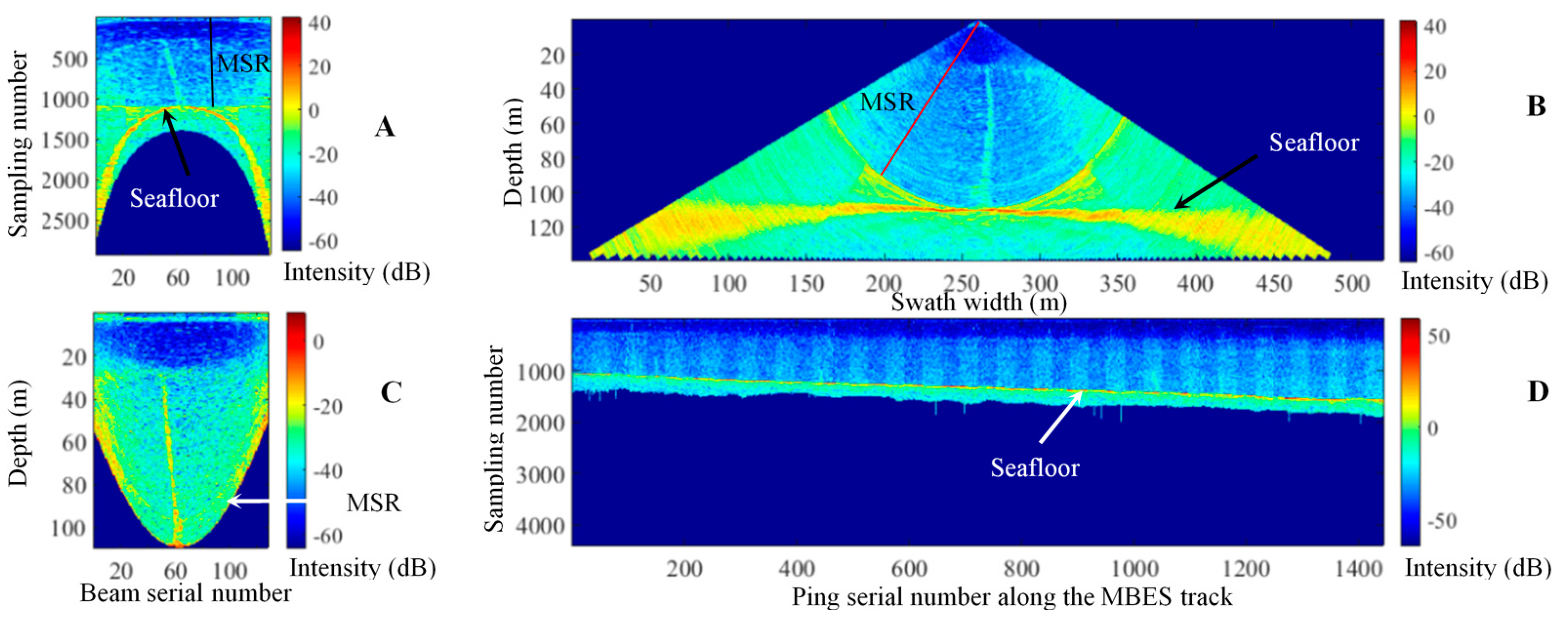



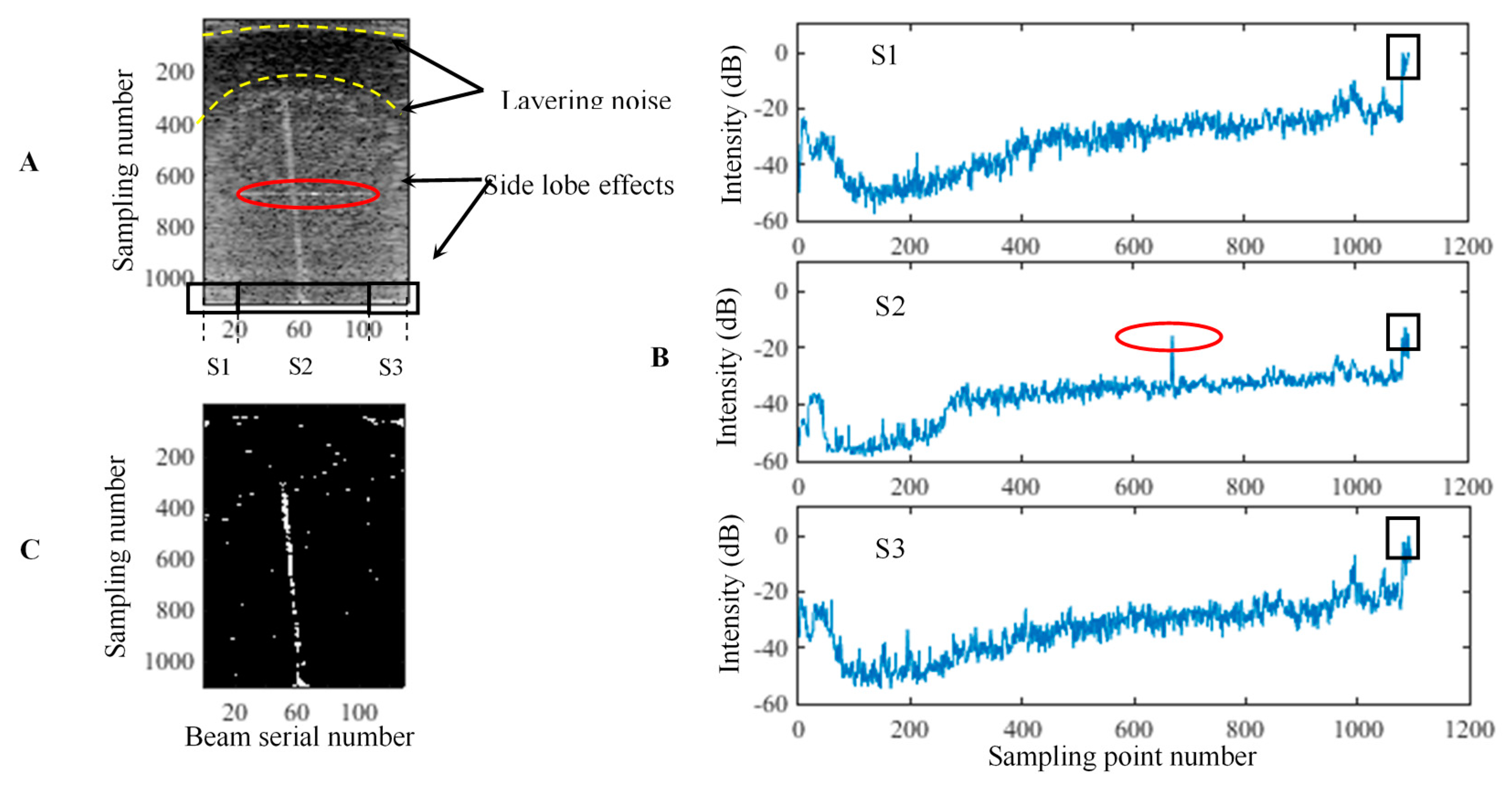
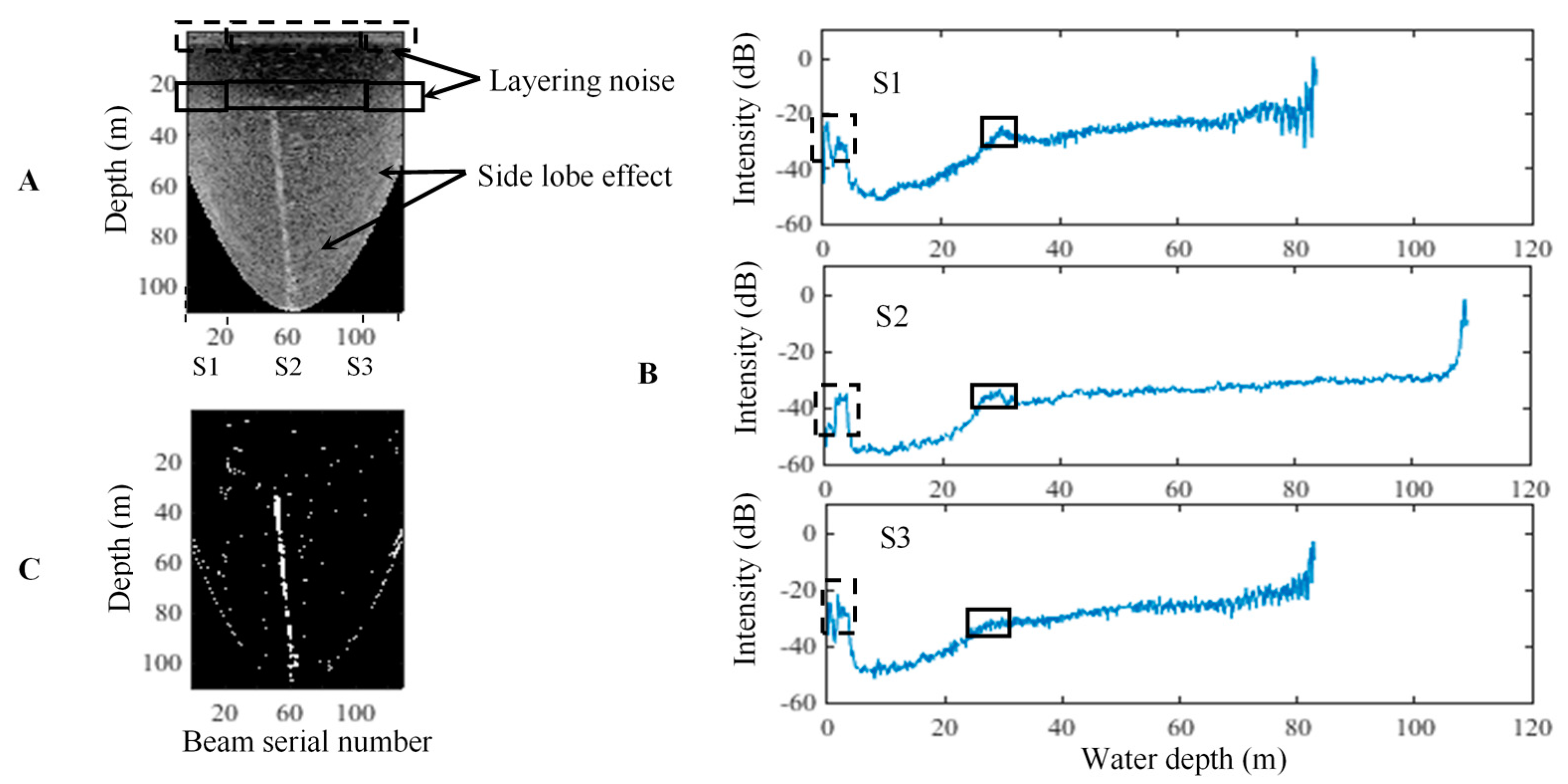
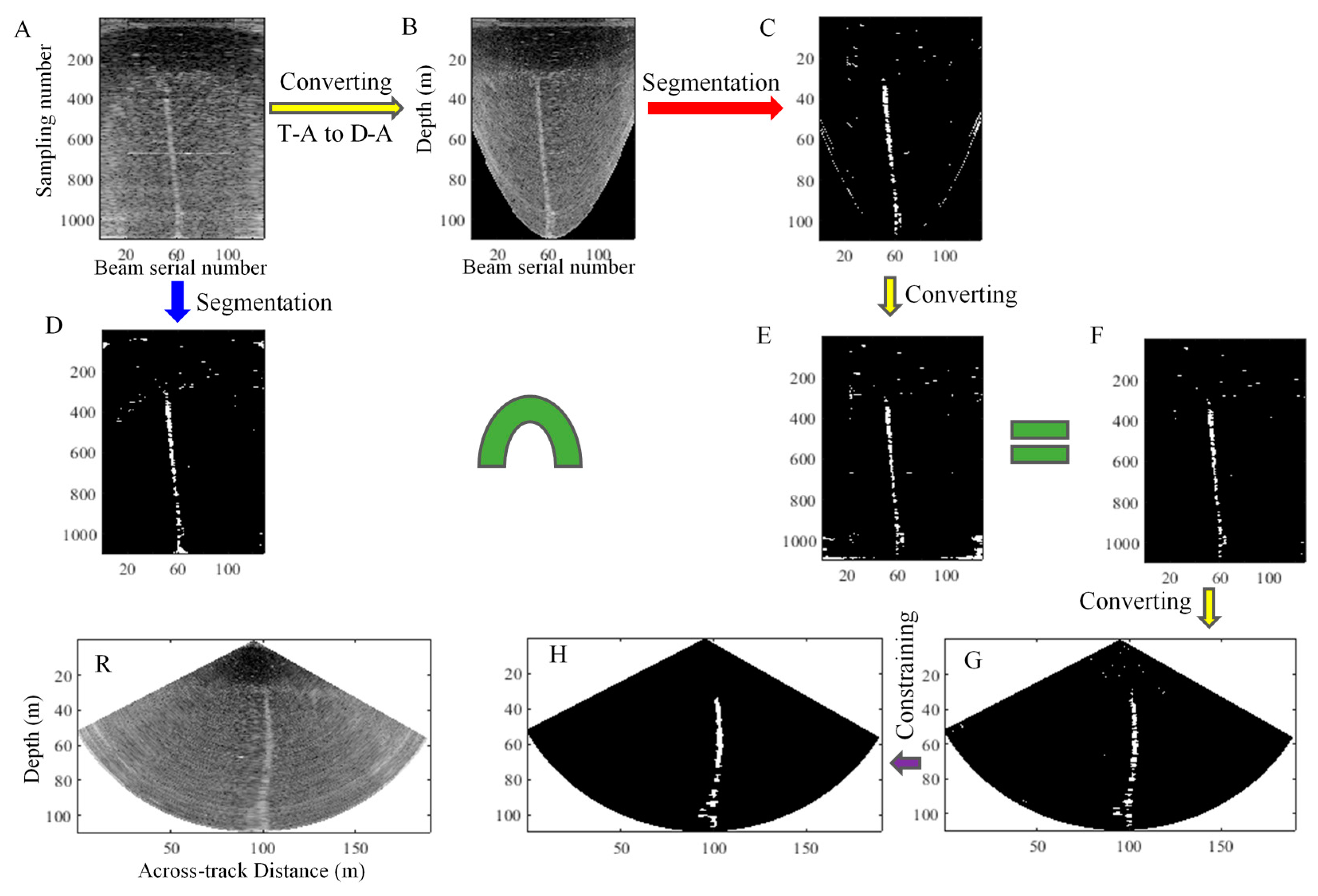
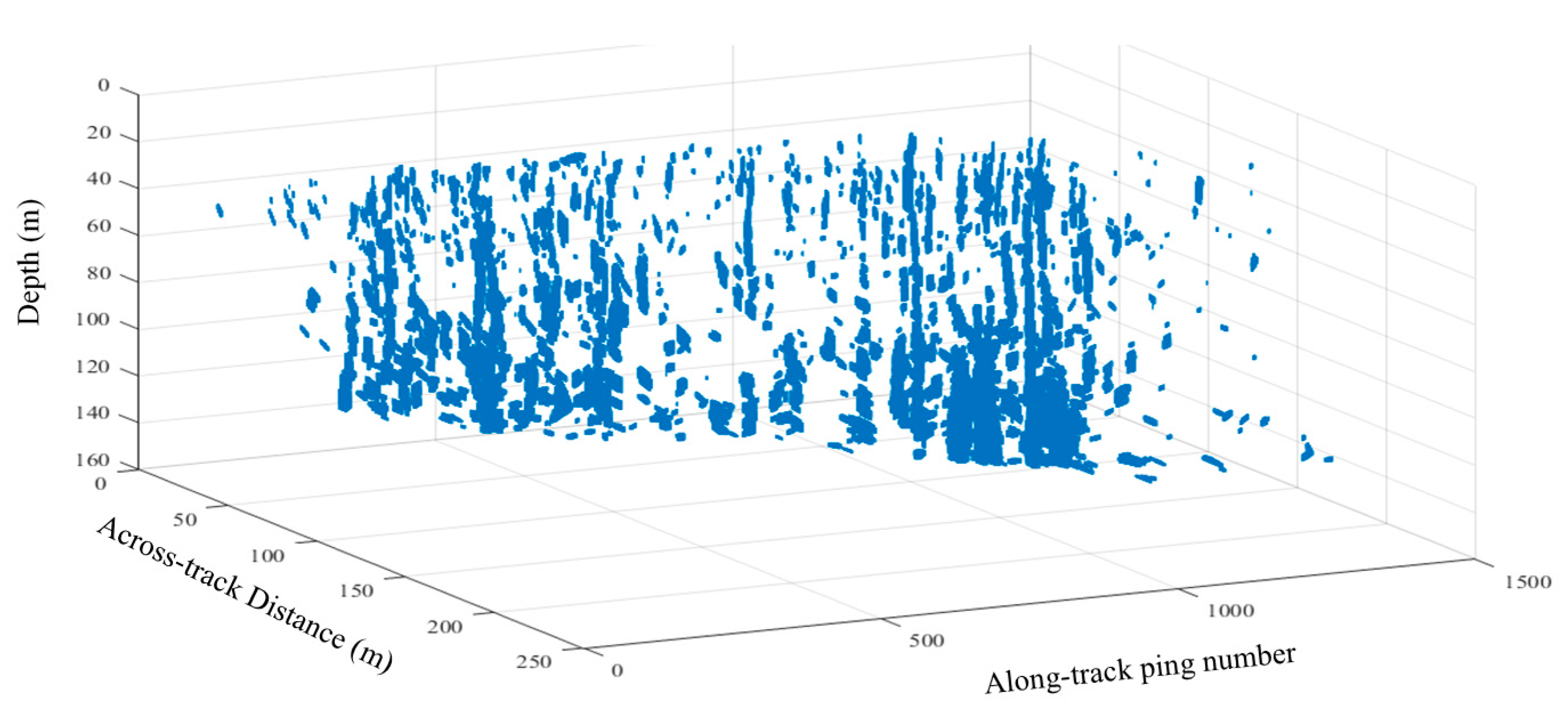
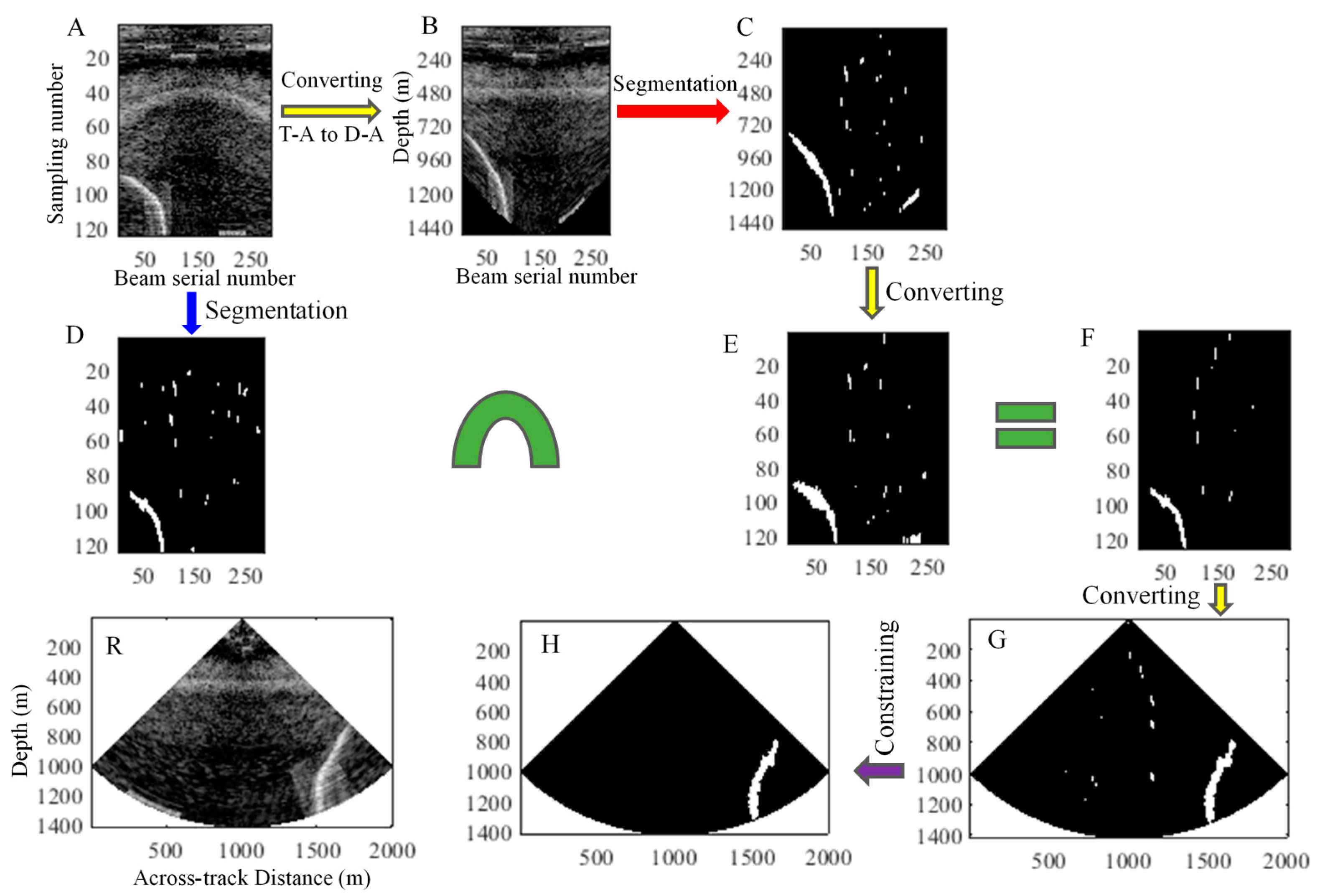
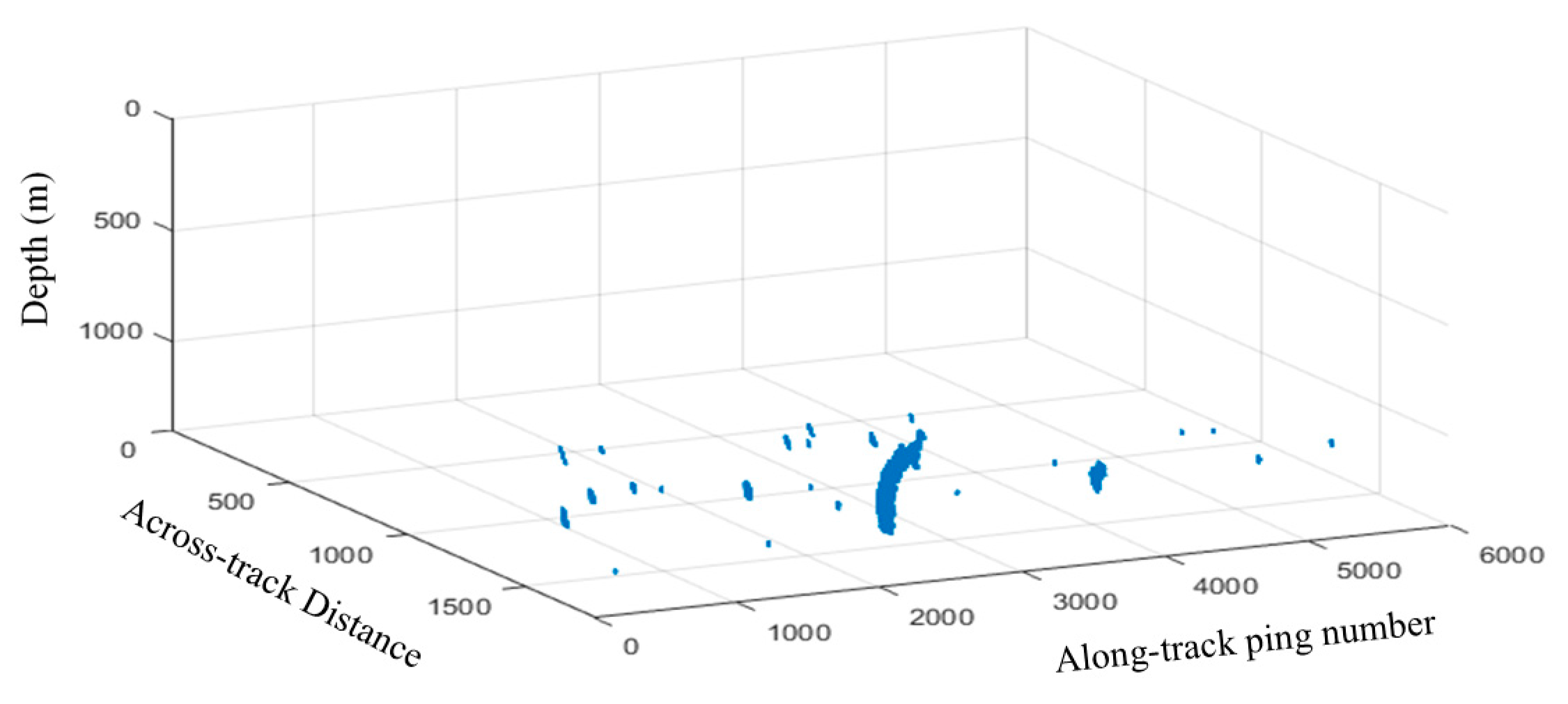

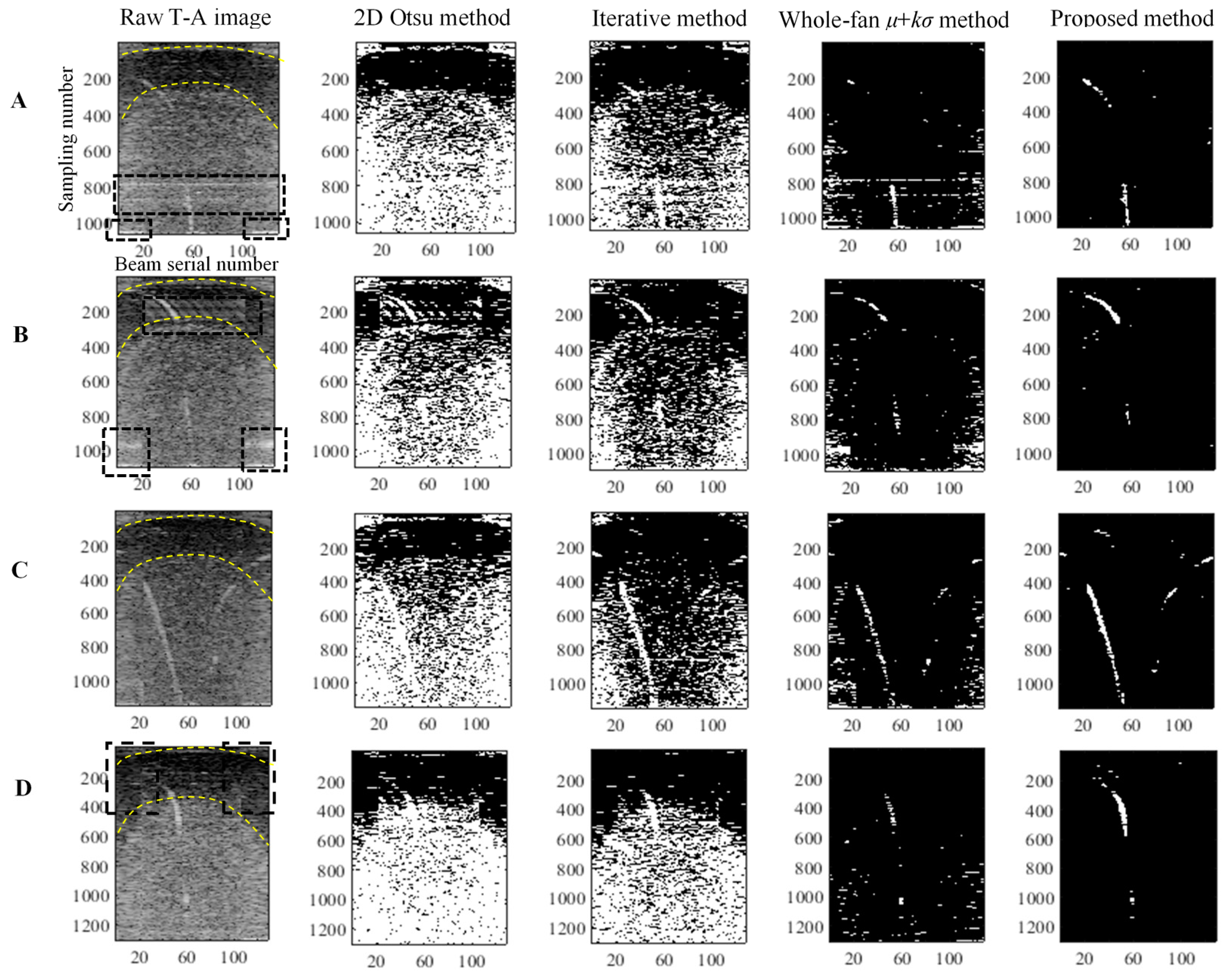
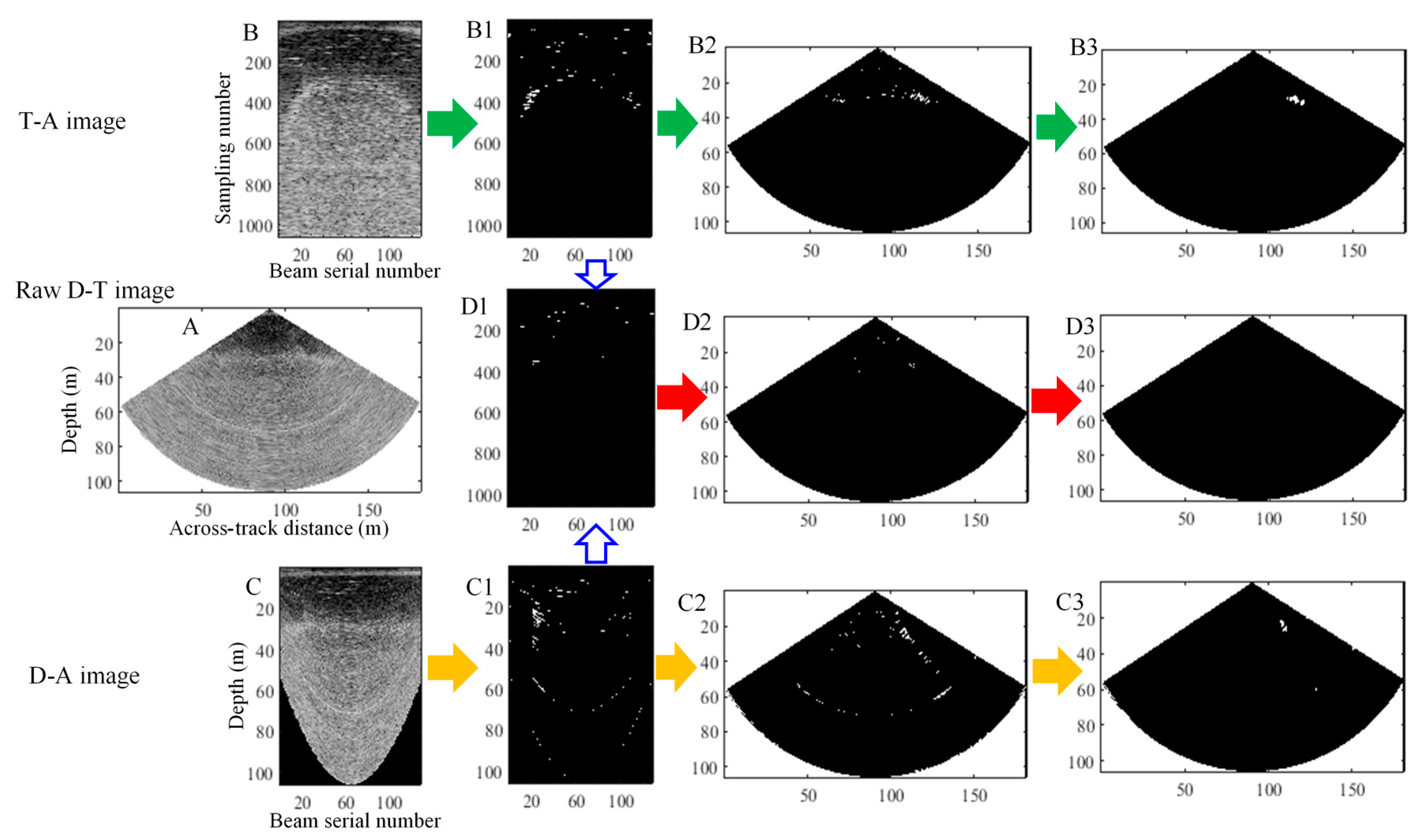
| Parameter | 2D Otsu | Iteration | Whole-Fan μ + kσ | Proposed Method |
|---|---|---|---|---|
| Correct detection rate (%) | 22/36 | 14/28 | 9/60 | 86/99 |
| Correct detection rate of gas plumes (%) | 3/10 | 1/10 | 10/4 | 86/80 |
| Time consumed (min) | 112/173 | 116/196 | 101/181 | 109/177 |
© 2017 by the authors. Licensee MDPI, Basel, Switzerland. This article is an open access article distributed under the terms and conditions of the Creative Commons Attribution (CC BY) license (http://creativecommons.org/licenses/by/4.0/).
Share and Cite
Zhao, J.; Meng, J.; Zhang, H.; Wang, S. Comprehensive Detection of Gas Plumes from Multibeam Water Column Images with Minimisation of Noise Interferences. Sensors 2017, 17, 2755. https://doi.org/10.3390/s17122755
Zhao J, Meng J, Zhang H, Wang S. Comprehensive Detection of Gas Plumes from Multibeam Water Column Images with Minimisation of Noise Interferences. Sensors. 2017; 17(12):2755. https://doi.org/10.3390/s17122755
Chicago/Turabian StyleZhao, Jianhu, Junxia Meng, Hongmei Zhang, and Shiqi Wang. 2017. "Comprehensive Detection of Gas Plumes from Multibeam Water Column Images with Minimisation of Noise Interferences" Sensors 17, no. 12: 2755. https://doi.org/10.3390/s17122755





